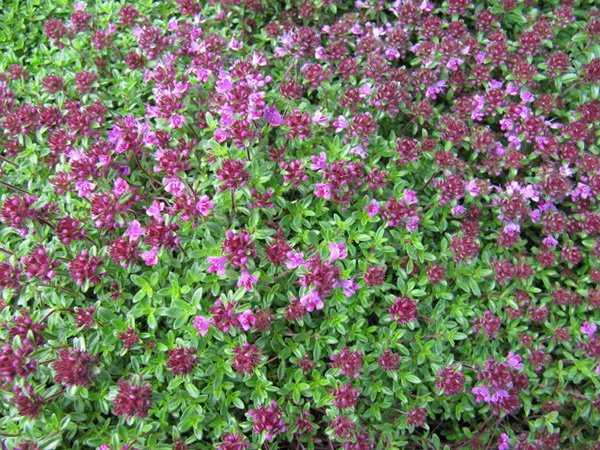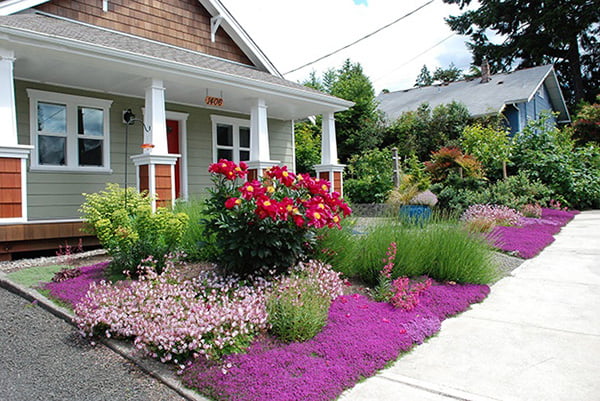If you're tired of mowing your grass lawn every Saturday during the summer or want to provide more food sources to local bees and butterflies, look to red creeping thyme! This spreading perennial herb doesn't need to be mowed, stays green through summer droughts and winter snows, and has beautiful red foliage that will serve pollinators well.
Whether you grow red creeping thyme as ground cover or are simply looking to use it to fill the space between rocks and stepping stones, this grow guide will tell you everything you need to know to make your thyme thrive and bloom.
Botanical Name
Common Name
Plant Type
Mature Size
Sun Requirement
Soil Type
Hardiness Zone
Pet Friendly
Thymus serpyllum 'Coccineus.'
Red creeping thyme
Perennial
3-4 inches tall and 12-18 inches wide
Full, partial
Sandy, loamy, and clay soils
4-9 (USDA)
Yes
What Is Red Creeping Thyme?
Red creeping thyme (Thymus praecox 'Coccineus') is one of the wide varieties of creeping thyme. It is low maintenance and low growing, reaching a mature height of only 3 to 4 inches. However, it will spread out a full 12 to 18 inches from its roots, covering the ground in small, dark green, lightly-scented leaves. As the stems spread and touch the soil, they root themselves and spread further. In the summer, it becomes a thick patch of red flowers, which are very attractive to butterflies and bees.
It is generally considered to be hardy in USDA zones 4-9, which covers a large portion of the United States. However, it is always a good idea to check your specific location's growing zone and consult with local gardening experts to determine the best conditions for planting and growing Red Creeping Thyme.
Red creeping thyme doesn't require a deep layer of soil to thrive, so it's a good choice for growing in the corners of your rock garden. It is also a hardy little plant that can handle foot traffic, making it perfect for planting between stepping stones and pavers or even as ground cover for an entire yard.
Creeping Thyme As A Lawn Replacement
We typically think of a lush green lawn of mowed grass or turf when visualizing a yard, but there are many reasons why you might want to consider a creeping thyme lawn instead.
It doesn't require mowing! Reaching heights of only 3 to 4 inches, it's not necessary to mow a red creeping thyme lawn. Imagine the time and hassle saved!
It's evergreen. Creeping thyme will stay green all year long, so you won't have a dead, brown yard in the winter and early spring. Additionally, it bursts into color in the summer, and who wouldn't love a lawn full of flowers?
It can handle foot traffic. Many people turn to grass for their lawns because it's hardy and doesn't mind being stepped on. But you have options! Creeping thyme can also handle moderate foot traffic.
It's drought-tolerant. No crunchy grass in the dry heat of summer! No need to run a sprinkler system! Think of the savings!
It benefits the ecosystem. A lawn without bees and butterflies is a dead lawn. It contributes nothing to the ecosystem. The blooms of red creeping thyme provide a food source that will bring pollinators to your doorstep. Additionally, it repels deer, rabbits, and mosquitoes!
It chokes weeds. For an even grass lawn, you are constantly battling weeds. The creeping nature of thyme means that it naturally chokes out weeds and keeps them under control.
It smells lovely. Thyme is an herb, so red creeping thyme will give off a pleasant aroma when it is stepped upon. It absolutely rivals the fragrance of freshly-cut grass. You won't even miss it.
When planting a lawn of creeping thyme, opt for broadcasting thyme seeds rather than planting individual thyme plants - that gets very expensive, very fast. Also, consider mixing up your thyme! Red creeping thyme is just one variety that works well as a groundcover. Elfin thyme (Thymus serpyllum 'Elfin') and wooly thyme (Thymus pseudolanuginosus) are also fantastic options.
Red Creeping Thyme Care Requirements
Light
Plants used as ground covers often need to handle an abundance of sunlight and grow well in the shade underneath trees and other structures. Red creeping thyme thrives in full sun locations and does well in partial sun areas, although the foliage in the spring won't be quite as robust.
Water
Red creeping thyme plants are drought-resistant, but freshly planted thyme requires water to get established. Gardeners should water thyme plants and seeds regularly for the first 3 to 6 months. After this time, there will be no need to water your thyme or run a sprinkler system in subsequent years unless a particularly heavy drought occurs.

Source: Flickr
Temperature
Red creeping thyme will thrive in USDA Hardiness Zones 4 through 10. It can handle both cold, wet winters and dry, hot summers.
Soil
Red creeping thyme can grow and thrive in soils that would kill other plants, making it a great grass replacement. It doesn't require a deep soil level, and grows happily between rocks and crevices. However, it is important that the soil has good drainage.
Fertilization
It isn't necessary to fertilize your creeping thyme plants regularly, but it will promote quick and healthy growth when first planted if you work bone meal, rock phosphate, or organic compost into the soil at the start.
Propagation
Red creeping is a perennial that has both self-seeds and self-roots. It typically grows so thickly that there is little reason to propagate it - simply dig up a small shovelful and divide it in the spring and early fall seasons! However, you can propagate red creeping thyme using stem cuttings if desired.
Pruning
One of the main benefits of creeping thyme is that it doesn't require mowing or pruning. However, some gardeners prefer to maintain their thyme lawns by mowing them when the blooms are spent.
Regular pruning, however, can help keep the plant tidy and encourage healthy growth. The best time to prune is early spring or mid-summer. If you prefer a more manicured appearance, you can lightly shear the plant throughout the growing season to maintain its shape and encourage bushier growth. Avoid cutting back more than a third of the plant's growth at any one time, as this can stress the plant and reduce its overall health and vigor.

Source: Flickr
Common Issue With Red Creeping Thyme
Root rot
Red Creeping Thyme prefers well-drained soil and can suffer from root rot if the soil is too wet. To prevent this, be sure to plant the thyme in well-draining soil and avoid overwatering.
Pests
Red Creeping Thyme is pest-resistant but can occasionally attract spider mites, thrips, or aphids. These pests can be controlled with insecticidal soap or neem oil.
Diseases
Red Creeping Thyme can be susceptible to fungal diseases such as powdery mildew or leaf spot. These diseases can be prevented by providing good air circulation around the plant and avoiding overhead watering.
Overcrowding
If Red Creeping Thyme is planted too closely together or allowed to grow unchecked, it can become overcrowded and straggly. To prevent this, thin out the plant as needed and trim back any overly long or leggy stems.
Is Red Creeping Thyme Pet Friendly?
Yes, red creeping thyme is safe for animals and small children. There is no danger of adverse reactions if thyme is ingested, and, in fact, it has many beneficial and medicinal properties.

